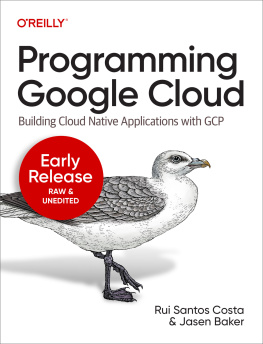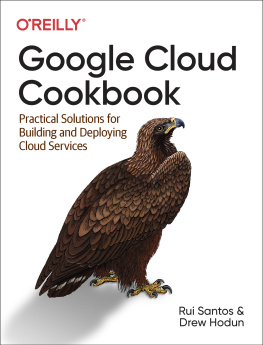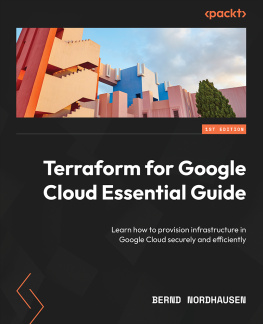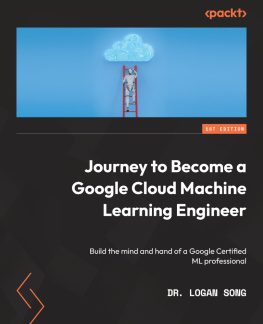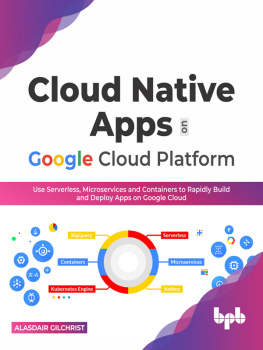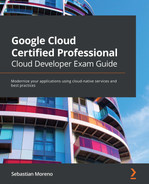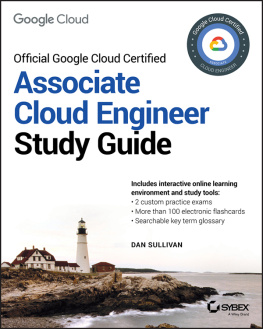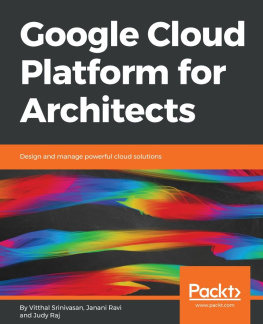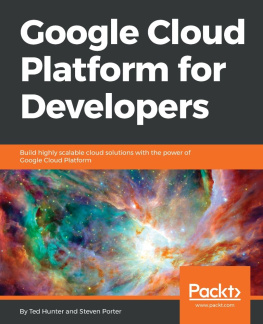Rui Costa - Programming Google Cloud
Here you can read online Rui Costa - Programming Google Cloud full text of the book (entire story) in english for free. Download pdf and epub, get meaning, cover and reviews about this ebook. year: 2022, publisher: OReilly Media, Inc., genre: Computer. Description of the work, (preface) as well as reviews are available. Best literature library LitArk.com created for fans of good reading and offers a wide selection of genres:
Romance novel
Science fiction
Adventure
Detective
Science
History
Home and family
Prose
Art
Politics
Computer
Non-fiction
Religion
Business
Children
Humor
Choose a favorite category and find really read worthwhile books. Enjoy immersion in the world of imagination, feel the emotions of the characters or learn something new for yourself, make an fascinating discovery.
- Book:Programming Google Cloud
- Author:
- Publisher:OReilly Media, Inc.
- Genre:
- Year:2022
- Rating:5 / 5
- Favourites:Add to favourites
- Your mark:
- 100
- 1
- 2
- 3
- 4
- 5
Programming Google Cloud: summary, description and annotation
We offer to read an annotation, description, summary or preface (depends on what the author of the book "Programming Google Cloud" wrote himself). If you haven't found the necessary information about the book — write in the comments, we will try to find it.
Rui Costa: author's other books
Who wrote Programming Google Cloud? Find out the surname, the name of the author of the book and a list of all author's works by series.
Programming Google Cloud — read online for free the complete book (whole text) full work
Below is the text of the book, divided by pages. System saving the place of the last page read, allows you to conveniently read the book "Programming Google Cloud" online for free, without having to search again every time where you left off. Put a bookmark, and you can go to the page where you finished reading at any time.
Font size:
Interval:
Bookmark:

by Rui Santos Costa and Jasen Baker
Copyright 2023 Rui Santos Costa. All rights reserved.
Printed in the United States of America.
Published by OReilly Media, Inc. , 1005 Gravenstein Highway North, Sebastopol, CA 95472.
OReilly books may be purchased for educational, business, or sales promotional use. Online editions are also available for most titles ( http://oreilly.com ). For more information, contact our corporate/institutional sales department: 800-998-9938 or corporate@oreilly.com .
- Editors: Michele Cronin and Jennifer Pollock
- Production Editor: Katherine Tozer
- Interior Designer: David Futato
- Cover Designer: Karen Montgomery
- Illustrator: Kate Dullea
- January 2022: First Edition
- 2020-08-10: First Release
- 2020-10-12: Second Release
- 2021-01-27: Third Release
- 2022-06-01: Fourth Release
See http://oreilly.com/catalog/errata.csp?isbn=9781492089032 for release details.
The OReilly logo is a registered trademark of OReilly Media, Inc. Building Cloud-Native Applications on Google Cloud, the cover image, and related trade dress are trademarks of OReilly Media, Inc.
The views expressed in this work are those of the author, and do not represent the publishers views. While the publisher and the author have used good faith efforts to ensure that the information and instructions contained in this work are accurate, the publisher and the author disclaim all responsibility for errors or omissions, including without limitation responsibility for damages resulting from the use of or reliance on this work. Use of the information and instructions contained in this work is at your own risk. If any code samples or other technology this work contains or describes is subject to open source licenses or the intellectual property rights of others, it is your responsibility to ensure that your use thereof complies with such licenses and/or rights.
978-1-492-08896-7
With Early Release ebooks, you get books in their earliest formthe authors raw and unedited content as they writeso you can take advantage of these technologies long before the official release of these titles.
This will be the 1st chapter of the final book. Please note that the GitHub repo will be made active later on.
If you have comments about how we might improve the content and/or examples in this book, or if you notice missing material within this chapter, please reach out to the editor at mcronin@oreilly.com.
This book is a journey; each chapter builds on itself. You can skip to the chapter of most interest, but to fully grasp Cloud Native applications running on Google Cloud its best to understand the use case and follow along through each chapter. We have designed the framework for you and now we will learn all the associated Google Cloud services of the framework that will be applied to our use case. We recommend that you revisit this chapter often to re-read the use case as it will allow you to grasp why certain services were chosen.
Lets begin by describing our fictional use case.
Pigeon Travel is an online travel agency. Pigeon Travels website and mobile application are used to book airline tickets, hotel reservations, and car rentals. They also have a large call center to provide support for their customers. The agents in the call center support their customers via live chat and call-in support.
For measuring customer satisfaction and calculating their Net Promoter Score, they provide the user with a survey at the end of the call or chat. A Net Promoter Score is a measurement used to answer the question: Will the customer recommend our product or service to a friend? Customers who respond 9 to 10 are called promoters, responses from 7 to 8 are called passive and responses from 0 to 6 are called detractors. The small percentage of users that leave feedback, the feedback provides for an overall low customer satisfaction and Net Promoter Score. Issues customers have raised are:
Call Availability: Long hold times before speaking or chatting with a customer representative
High Handling Rates
Pigeon Travel also noticed a high abandonment rate which correlates to the call availability issue listed by their customers.
The business has asked you as the lead developer to put a plan together and a prototype on how Pigeon Travel can increase the Net Promoter Score, increase customer satisfaction, and provide the following metrics to the business:
Customer Sentiment
Call Topics (Why are users calling?)
Understanding Trending Topics
Understanding call quality including Silence Scores, Call Duration and Call Escalation Paths.
We can meet some objectives of the business by taking a potentially biased and inefficient manual approach which would require analysts to randomly select calls to collect the key performance indicators. However, the framework which we will cover in a few will allow us to use Google Cloud services to meet the goals and analyze all recorded calls to get insights in near real-time. These insights can include:
Overall call sentiment.
Sentence-by-sentence sentiment.
Insight into which agent quality metrics to track (such as call silence, call duration, agent speaking time, user speaking time, and sentence heatmaps).
Insights on how to reduce call center volume by analyzing keywords in transcripts.
Now that we know the business objectives, we need to define the framework. How we can define a framework without knowing the services available from Google Cloud? The rest of the chapters in the book do just that. For now, I have defined a framework for you that will guide you through the book, and shows the architecture we will work through.
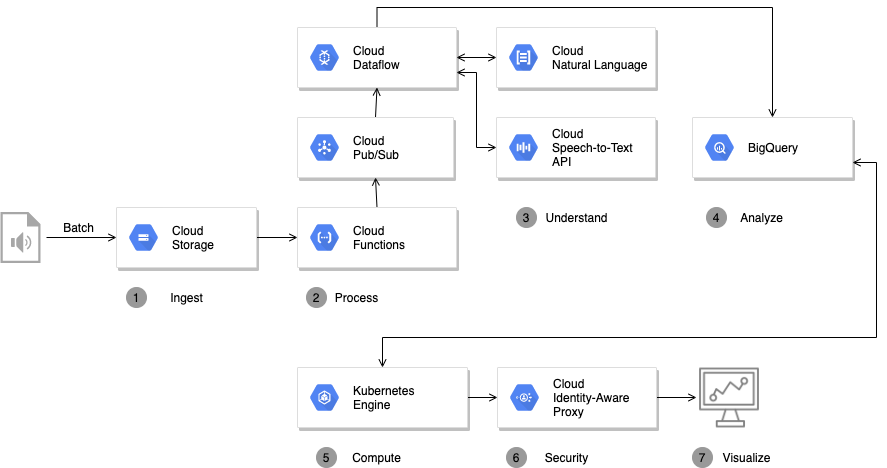
The framework presented in this book uses Google Cloud AI services such as Speech-to-Text and Cloud Natural Language API. The framework also employs Pub/Sub, a messaging system, and Dataflow, a data processing framework, used for data streaming and transformation. The resulting framework consists of a cloud-native and server-less job running in Google Cloud. To implement the framework, you dont need any machine learning experience, and all the data infrastructure needs, such as storage, scaling, and security, are managed by Google Cloud. While we have chosen Google Cloud as the platform, you have many choices such as Amazon Web Services and Azure. They both have similar offerings to Google Cloud that will allow you to translate the Framework components to their offerings to fully a working framework. However, we wanted a wide partner ecosystem of Business Intelligence Tools, as well as have Google scale querying for the large amounts of data that will be created from our transcription of the audio files thus Google Cloud is the best fit for our requirements.
Throughout the book, cloud-native applications are loosely defined as an approach to building applications that take advantage of cloud computing resources. It is often associated with public clouds, but can also be used with on-prem clouds. Cloud native applications are defined by how they are deployed, rather than where they are deployed. A cloud-native application will leverage the perceived limitless resources available. For Google Cloud, a cloud-native application can scale up and down as needed, the application is built to use and release resources based on the rules defined.
Font size:
Interval:
Bookmark:
Similar books «Programming Google Cloud»
Look at similar books to Programming Google Cloud. We have selected literature similar in name and meaning in the hope of providing readers with more options to find new, interesting, not yet read works.
Discussion, reviews of the book Programming Google Cloud and just readers' own opinions. Leave your comments, write what you think about the work, its meaning or the main characters. Specify what exactly you liked and what you didn't like, and why you think so.

